The ASUS X99-E-10G WS Motherboard Review: 10GBase-T Networking with Intel’s X550-AT2
by Ian Cutress on November 7, 2016 9:00 AM EST- Posted in
- Motherboards
- Intel
- Asus
- 10G Ethernet
- X99
- 10GBase-T
- X99-E-10G WS
- X550
- X550-AT2
CPU Performance, Short Form
For our motherboard reviews, we use our short form testing method. These tests usually focus on if a motherboard is using MultiCore Turbo (the feature used to have maximum turbo on at all times, giving a frequency advantage), or if there are slight gains to be had from tweaking the firmware. We leave the BIOS settings at default and memory at JEDEC (DDR4-2133 C15) for these tests, making it very easy to see which motherboards have MCT enabled by default.
Video Conversion – Handbrake v0.9.9: link
Handbrake is a media conversion tool that was initially designed to help DVD ISOs and Video CDs into more common video formats. For HandBrake, we take two videos (a 2h20 640x266 DVD rip and a 10min double UHD 3840x4320 animation short) and convert them to x264 format in an MP4 container. Results are given in terms of the frames per second processed, and HandBrake uses as many threads as possible.
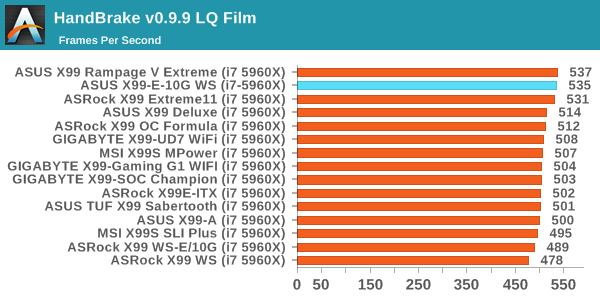
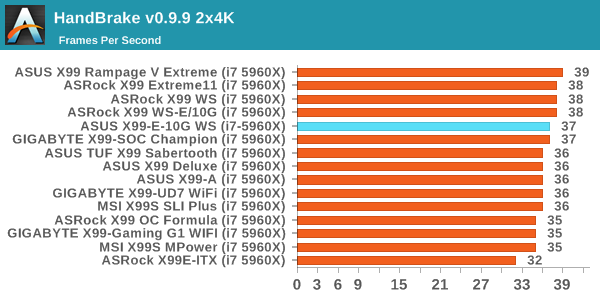
Compression – WinRAR 5.0.1: link
Our WinRAR test from 2013 is updated to the latest version of WinRAR at the start of 2014. We compress a set of 2867 files across 320 folders totaling 1.52 GB in size – 95% of these files are small typical website files, and the rest (90% of the size) are small 30 second 720p videos.
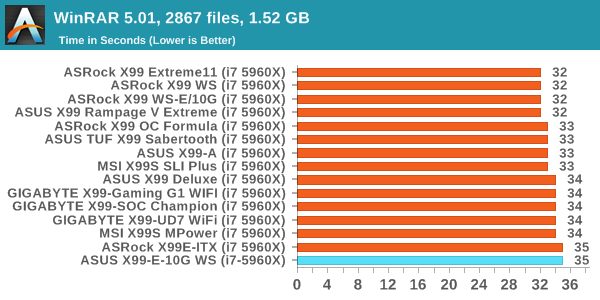
Point Calculations – 3D Movement Algorithm Test: link
3DPM is a self-penned benchmark, taking basic 3D movement algorithms used in Brownian Motion simulations and testing them for speed. High floating point performance, MHz and IPC wins in the single thread version, whereas the multithread version has to handle the threads and loves more cores. For a brief explanation of the platform agnostic coding behind this benchmark, see my forum post here.
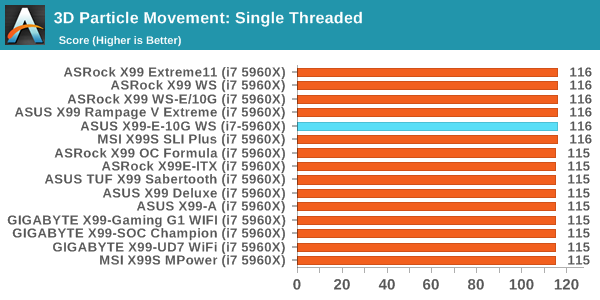

Rendering – POV-Ray 3.7: link
The Persistence of Vision Ray Tracer, or POV-Ray, is a freeware package for as the name suggests, ray tracing. It is a pure renderer, rather than modeling software, but the latest beta version contains a handy benchmark for stressing all processing threads on a platform. We have been using this test in motherboard reviews to test memory stability at various CPU speeds to good effect – if it passes the test, the IMC in the CPU is stable for a given CPU speed. As a CPU test, it runs for approximately 2-3 minutes on high end platforms.
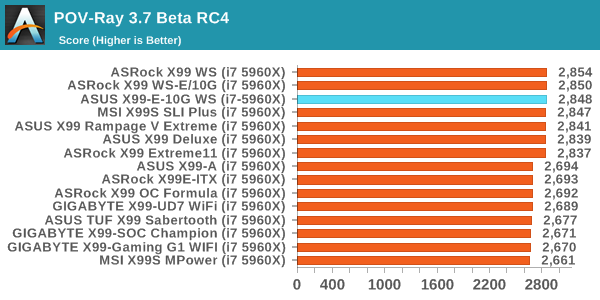
Synthetic – 7-Zip 9.2: link
As an open source compression tool, 7-Zip is a popular tool for making sets of files easier to handle and transfer. The software offers up its own benchmark, to which we report the result.
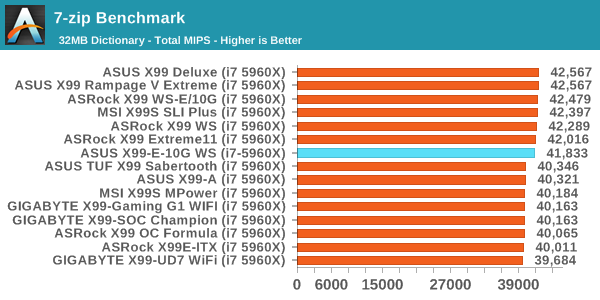










63 Comments
View All Comments
Notmyusualid - Friday, December 2, 2016 - link
TB3 IS great! - but not for the use case you describe, I think.r3loaded - Monday, November 7, 2016 - link
So why exactly IS 10G so expensive? Is there some inherent technical reason, or is it just Intel doing what Intel does best with a captive market over which they have a near monopoly?jhh - Monday, November 7, 2016 - link
Volume. There is a certain amount of engineering involved in making the NIC, and if you expect to sell 100,000, you recoup that engineering expense differently than if you expect to sell 10,000,000. I'm sure the volume is somewhere between those two targets. Volume will be limited if for no other reason that most devices connect via WiFi, and that until WiFi routers come with something other than a 1G port, it's hard to drive the market for 10G. The server environment is different, but fewer servers are sold than laptop/tablet/phone. No one is selling > 1G Internet to the residential market, so even that option isn't driving the market. One is then limited to people with the need to transfer at more than 1G speeds within a residence, and that market is small. Servers tend to use fiber, as the signal processing to support 10G over copper was historically adding significant latency compared to fiber. Fiber is also more forward compatible to 25G than copper, as every speed transition has always required different cables. Unless you are installing Cat 7a wire and proprietary connectors, but they aren't directly compatible with 1G wiring.Communism - Monday, November 7, 2016 - link
http://ark.intel.com/products/84329/Intel-Ethernet...The price per thousand is down to 80 USD for the controller (Which provides 2x 10G base-t ports), meaning one could theoretically integrate it into an x99 (or the boards coming out for Skylake-E/X) for around that much if you could get enough traction to be able to put them in a board with a significant portion of sales.
This sounds entirely feasible, unfortunately, they seem to be stuck on boards that are made purely for manufacturer advertising with hilarious prices like 700 USD.
Integrating such a controller is simple, as it's just a PCIe 3.0 x4 device.
Hopefully at least 1 of the major board manufacturers starts making reasonable integrations with the X550-AT2 controller in the Skylake-E/X generation boards.
bronan - Friday, November 11, 2016 - link
Intel sold their 10G cards for under 100 dollar each, when companies jumped onto them they slowly upped the prices to the max. These cards can be sold for under 50 dollar each but the hunger for huge profits will not allow thatBillR - Tuesday, November 8, 2016 - link
Terrific answer. 1G is everywhere and cost for those ports shows the power of huge volumes on prices. However, 10G is mostly limited to servers and there is a lot of competition for server connections (25G, 40G, 50G, 100G, Infiniband, etc.). Unfortunately fragmentation means higher prices.Ranger1065 - Monday, November 7, 2016 - link
zzzZZzzz.....bronan - Friday, November 11, 2016 - link
These chips cost really nothing for the gaints, the real prices of these chips are absolute below 10 dollar each. Again intel sold full fledged pci cards if i remember well around 77 dollar thats consumer price. See what happened after the companies started adopted them. I can't believe everbody makes it look like it so expenssive to make chips.... They cost them a few bucks to make thats it not 50 dollar+ my company makes chips for certain installations they costs 0.04 cents each and are sold to companies for 11 cents each ... talking about making profit. Thats the real prices you as consumer pay for that same 11 cents .... 10 dollar+ yes thats how the market works these days enormous profit is all what countsnirsever - Tuesday, November 8, 2016 - link
In fact, the footprint of the Tehuti Networks based solutions with PHYs from either Marvell or Aquantia are way smaller than the Intel X550 and since they don't require a heat sink, consuming ~5W max (for both MAC and PHY), they are much easier to integrate. The Tehuti Networks solutions are already supporting 2.5G and 5G in addition to standard 10GBase-T. You can find Tehuti Networks based 5-speed NIC cards already selling today for ~$200 while this figure is expected to drop significantly once new Marvell 802.3bz PHYs will start shipping in volumes early next yearnirsever - Tuesday, November 8, 2016 - link
Please take a look at what you can expect from Tehuti Networks and Marvell new PHY:http://www.tehutinetworks.net/?t=LV&L1=3&L...